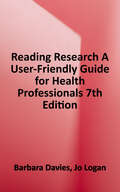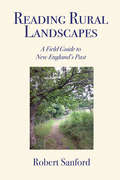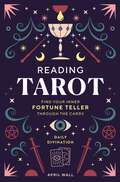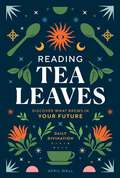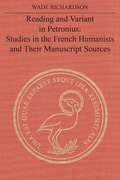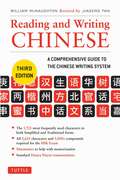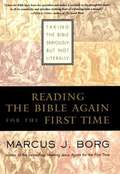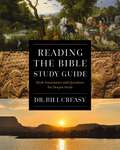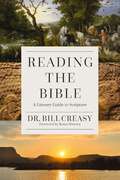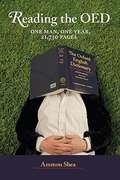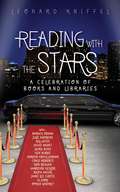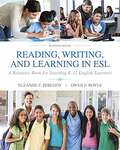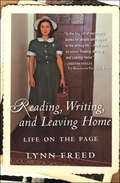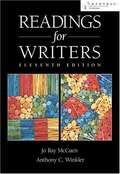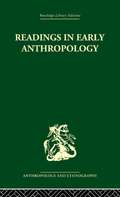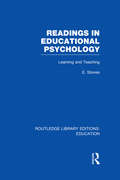- Table View
- List View
Reading Research: A User-friendly Guide for Health Professionals
by Barbara Davies Jo LoganLearn how to evaluate and apply health sciences research with this beginner's guide! Reading Research: A User-Friendly Guide for Health Professionals, 7th Edition provides a clear introduction to reading and understanding research articles, with practical guidelines for implementing research into clinical practice. It describes how to interpret common research methods including qualitative, quantitative, and mixed-method approaches, and explains how to find relevant, reliable research on the internet. <P><P>Written by Barbara Davies and Jo Logan, both of whom are noted educators and research experts, this easy-to-use pocket guide is ideal for both students and health professionals.
Reading Rural Landscapes: A Field Guide to New England's Past
by Robert SanfordWilliam Faulkner once said, "The past is never dead. It's not even past." Nowhere can you see the truth behind his comment more plainly than in rural New England, especially Maine, New Hampshire, Vermont, and western Massachusetts. Everywhere we go in rural New England, the past surrounds us. In the woods and fields and along country roads, the traces are everywhere if we know what to look for and how to interpret what we see. A patch of neglected daylilies marks a long-abandoned homestead. A grown-over cellar hole with nearby stumps and remnants of stone wall and orchard shows us where a farm has been reclaimed by forest. And a piece of a stone dam and wooden sluice mark the site of a long-gone mill. Although slumping back into the landscape, these features speak to us if we can hear them and they can guide us to ancestral homesteads and famous sites. Notable Features: -Lavishly illustrated with drawings and color photos. -Provides the keys to interpret human artifacts in fields, woods, and roadsides and to reconstruct the past from surviving clues. -Perfect to carry in a backpack or glove box. -A unique and valuable resource for road trips, genealogical research, naturalists, and historians.
Reading Tarot: Find Your Inner Fortune Teller Through the Cards
by April WallReading Tarot not only teaches you how to perform tarot readings but also provides clarity on what matters the most in your life. Whether offering insight into relationships and careers paths or providing a sense of calm and clarity for the day, reading tarot cards is an easy way to practice self-care and self-reflection. Professional tarot card reader April Wall provides guidance throughout all aspects of tarot reading and what you can discover about yourself along the way. For years, April has performed tarot readings for clients in search of answers and teaches how to explore your past, present, and future.This beautifully illustrated guide compiles her years of experience to teach you how to accurately interpret 78 major and minor arcana tarot cards and connect your insights to real-life experiences. Complete with numerous examples, traditional card spread types, and tips to apply what you learn in various love, work, and life scenarios, Reading Tarot gives you all the tools you will need to conduct impactful readings on yourself and others. Take hold of your mystical journey and find the answers in the cards! ALL OF YOUR TAROT QUESTIONS ANSWERED: The only tarot guidebook you will ever need! With thorough explanations, a history of the practice, and application tips, this book is the complete package EXPERT GUIDANCE: Written by an expert in metaphysical practice, this book is an authentic and reliable guide to the practice of tarot EASY TO LEARN: With step-by-step instructions and clear explanations, this guidebook is perfect for any skill level PERFECT GIFT: This book makes the perfect gift for any tarot enthusiast in your life COMPLETE THE SERIES: Collect all of the books in the Daily Divination series with Reading Tarot, Reading Tea Leaves, and more!
Reading Tea Leaves: Discover What Brews in Your Future
by April WallReading Tea Leaves: Discover What Brews in Your Future is the perfect resource to master the ancient practice of tea leaf reading, also known as tasseography, and will teach you everything you need to know to learn and interpret the hidden messages that lie in the shapes of the tea leaves. Author April Wall, a spirit-led psychic intuitive, provides an easy explanation to all aspects of the practice and what you can discover about yourself, the future, and the divination power of reading tea leaves. For years, April has performed tea leaf readings for clients in search of answers. This beautifully illustrated guide compiles her years of knowledge and real-life experience to teach you how to confidently interpret over 100 consistent tea leaf patterns and configurations. Complete with a glossary, step-by-step instructions, and insider tips and tricks, Reading Tea Leaves gives you all the tools you will need to perform your very own tea leaf readings. Take hold of your journey and find the answers you have been looking for! 100+ TEA LEAF SYMBOLS EXPLAINED: With over 100 symbols and configurations explained, you will find success in your tea leaf readings every time EASY TO LEARN: This ancient divination practice is made easy with step-by-step instructions that make learning to read tea leaves simple HELPFUL ILLUSTRATIONS: Each tea leaf symbol will be accompanied by an illustration to help readers accurately interpret the symbols PERFECT GIFT: This guide makes a perfect gift for the aspiring psychic or fan of mysticism in your life COMPLETE THE SERIES: Collect all of the books in the Daily Divination series with Reading Tea Leaves, Reading Tarot, and more!
Reading and Variant in Petronius: Studies in the French Humanists and their Manuscript Sources (The Royal Society of Canada Special Publications)
by Wade T. RichardsonCritical editions of most classical authors are based on readings transmitted by medieval scholars that can be examined and collated. Modern editions of Petronius, on the other hand, are principally based on printed editions, most of them published in France during the sixteenth century. In this volume T. Wade Richardson considers the use made of the Petronius manuscripts then extant by seven French humanist editors for their various editions, commentaries, and notes.Some of the manuscripts they used may be equated with extant exemplars, which therefore serve as a good check on the quality of their readings. But as much as half of the text rests on the sixteenth-century witness alone. Through a broad and integrated study of the problems of the Petronius text the author attempts to unravel the tangled skein of humanist work on Petronius, to settle some of the old textual puzzles, and to solidify the text and recast the apparatus.Richardson also provides information on the codicology and palaeography of the texts and on the talents and habits of the scholars who created them.
Reading and Writing
by Laura Robb Ruth NathanThis is a sourcebook that intends to enhance the readers' reading and writing skills.
Reading and Writing Cancer: How Words Heal
by Susan GubarAn important addition to the literature of cancer by an award-winning scholar and memoirist. Elaborating upon her "Living with Cancer" column in the New York Times, Susan Gubar helps patients, caregivers, and the specialists who seek to serve them. In a book both enlightening and practical, she describes how the activities of reading and writing can right some of cancer's wrongs. To stimulate the writing process, she proposes specific exercises, prompts, and models. In discussions of the diary of Fanny Burney, the stories of Leo Tolstoy and Alice Munro, numerous memoirs, novels, paintings, photographs, and blogs, Gubar shows how readers can learn from art that deepens our comprehension of what it means to live or die with the disease. From a writer whose own memoir, Memoir of a Debulked Woman: Enduring Ovarian Cancer, was described by the New York Times Book Review as "moving and instructive...and incredibly brave," this volume opens a path to healing.
Reading and Writing Chinese
by William Mcnaughton Jiageng FanThis is a compete and easy-to-use guide for reading and writing Chinese characters.Used as a standard by students and teachers in learning Chinese for more than three decades, the bestselling Reading & Writing Chinese has been completely revised and updated. Reading & Writing Chinese places at your fingertips the essential 1,725 Chinese characters' up-to-date definitions, derivations, pronunciations, and examples of correct usage by means of cleverly condensed grids. This guide also focuses on Pinyin, which is the official system to transcribe Hanzi, Chinese characters, into Latin script, now universally used in mainland China and Singapore. Traditional characters (still used in Taiwan and Hong Kong) are also included, making this a complete reference.Newly updated and revised, these characters are the ones officially prescribed by the Chinese government for the internationally recognized test of proficiency in Chinese, the Hanyu Shuiping Kaoshi (HSK). Key features of this newly-expanded edition include:The 1,725 most frequently used characters in both Simplified and Traditional formsAll 2,633 characters and 5,000+ compounds required for the HSK ExamMnemonics to help with memorizationStandard Hanyu Pinyin romanizations More mnemonic phrases and etymologies to help you remember the characters An extensive introduction, alphabetical index, and index according to stroke count and stroke order Completely updated/expanded English definitions Convenient quick-reference tables of radicals Updated and revised compounds, plus 25% more vocabulary now offered Codes to assist those who are preparing for the AP exam or the HSK exam
Reading and Writing Chinese
by William Mcnaughton Jiageng FanThis is a complete and easy-to-use guide for reading and writing Chinese characters.Learning written Chinese is an essential part of mastering the Chinese language. Reading & Writing Chinese places at your fingertips the essential 1,725 Chinese characters' up-to-date definitions, derivations, pronunciations, and examples of correct usage by means of cleverly condensed grids.Newly updated and revised, these characters are the ones officially prescribed by the Chinese government for the internationally recognized test of proficiency in Chinese, the Hanyu Shuiping Kaoshi (HSK). The student's ability to read Chinese and write Chinese are reinforced throughout.Key features of this newly-expanded edition include: The 1,725 most frequently used characters in both Simplified and Traditional forms. All 2,633 characters and 5,000+ compounds required for the HSK Exam. Standard Hanyu Pinyin romanizations. More mnemonic phrases and etymologies to help you remember the characters. An extensive introduction, alphabetical index, and index according to stroke count and stroke order. Completely updated/expanded English definitions. Convenient quick-reference tables of radicals. Updated and revised compounds, plus 25% more vocabulary now offered. Codes to assist those who are preparing for the AP exam or the HSK exam.
Reading and Writing Math Using Windows Based Applications - WBM (World Bank Modules)
by BookshareThis instructional module focuses on enhancing math literacy among teachers and students with visual impairments through Windows-based applications. It begins by addressing the challenges encountered in accessing mathematical content and outlines the learning objectives for the module. Detailed guidance is provided on utilizing Thorium Reader, a versatile reading app supporting various document formats, with screen readers like NVDA, JAWS, and Narrator to access math content. Moreover, the module extensively covers writing math expressions in Microsoft Word, highlighting keyboard shortcuts, the equation editor, and handwriting features while offering tips and links to additional resources. It delves into an overview of assistive technologies like MathType, MathML, EPUB, LaTeX, and Pandoc for reading and writing math, comparing their advantages and suggesting suitable options based on user profiles and needs. Additionally, it explores the feasibility of reading and writing math in Indian languages, acknowledging limitations and challenges. The page concludes by listing the system and software specifications used for testing the solutions elucidated within the module, ensuring comprehensive coverage of accessibility solutions across multiple platforms and applications.
Reading and Writing from Literature: AP Version (3rd edition)
by John E. SchwiebertDesigned for use in literature courses that are also writing courses, Reading and Writing from Literature offers a fresh new approach to reading and writing in those classes. The book invokes a "conversation" model of reading and writing that empowers students to interact proactively and constructively with all texts, both literary and their own. Reading and Writing from Literature presents reading as the primary resource for writing. Rather than only writing about literature, student users of this book write from literature; they use texts to produce texts. Being personally and culturally diverse, students are encouraged to identify and use those aspects of a text that interest them most as starting points for composing. Throughout the book, the guiding assumption is that, by creating, students also become stronger readers of the literature of past and present.
Reading for the Plot
by Peter BrooksA book which should appeal to both literary theorists and to readers of the novel, this study invites the reader to consider how the plot reflects the patterns of human destiny and seeks to impose a new meaning on life.
Reading the Bible Again for the First Time: Taking the Bible Seriously but Not Literally
by Marcus J. BorgOne of the vital challenges facing thoughtful people today is how to read the Bible faithfully without abandoning our sense of truth and history. Reading the Bible Again for the First Time provides a much-needed solution to the problem of how to have a fully authentic yet contemporary understanding of the scriptures. Many mistakenly believe there are no choices other than fundamentalism or simply rejecting the Bible as something that can bring meaning to our lives. Answering this modern dilemma, acclaimed author Marcus Borg reveals how it is possible to reconcile the Bible with both a scientific and critical way of thinking and our deepest spiritual needs, leading to a contemporary yet grounded experience of the sacred texts. This seminal book shows you how to read the Bible as it should be examined -- in an approach the author calls "historical-metaphorical." Borg explores what the Scriptures meant to the ancient communities that produced and lived by them. He then helps us to discover the meaning of these stories, providing the knowledge and perspective to make the wisdom of the Bible an essential part of our modern lives. The author argues that the conventional way of seeing the Bible's origin, authority, and interpretation has become unpersuasive to millions of people in our time, and that we need a fresh way of encountering the Bible that takes the texts seriously but not literally, even as it takes seriously who we have become. Borg traces his personal spiritual journey, describing for readers how he moved from an unquestioning childhood belief in the biblical stories to a more powerful and dynamic relationship with the Bible as a sacred text brimming with meaning and guidance. Using his own experience as an example, he reveals how the modern crisis of faith is itself rooted in the misinterpretation of sacred texts as historical record and divine dictation, and opens readers to a truer, more abundant perspective. This unique book invites everyone -- whatever one's religious background -- to engage the Bible, wrestle with its meaning, explore its mysteries, and understand its relevance. Borg shows us how to encounter the Bible in a fresh way that rejects the limits of simple literalism and opens up rich possibilities for our lives.
Reading the Bible Study Guide: Book Summaries and Questions for Deeper Study
by William C. CreasyFollowing the structure of Reading the Bible, this corresponding study guide offers assessment questions, exercises, and visuals designed to support deep learning experiences in each book of the Bible by unveiling its rich literary genres and ancient Near Eastern origins. Recognized as among the top two percent of educators in the U.S., Creasy challenges the notion that the Bible is simply an anthology, instead revealing it as a collection of 'little books' that warrant meticulous exploration.The Reading the Bible Study Guide includes:Maps to help understand the land of the Bible betterQuestions about the narrative features of each biblical bookSummaries of the chapters from the main bookDiscussion questions to facilitate group engagement in classroom, church, or small group settings With the aim of nurturing "knowledgeable readers of Scripture" who can both comprehend and apply its teachings within their own life, this study guide serves as an indispensable guide for those seeking a profound understanding of the world's most influential text.For use with Reading the Bible by Dr. Bill Creasy. Together, the book and study guide make a perfect combination for group Bible study programs in churches, schools, and seminaries!
Reading the Bible: A Literary Guide to Scripture
by William C. CreasyLearn how to read the Bible as literature and fall in love with God's Word.We all want to read the Bible verse-by-verse, cover-to-cover, but what happens when you can't get past Leviticus or bog down and quit in Chronicles? How can you make the journey through the Bible spring to life with unforgettable characters, drama, and glittering poetry and prose?In Reading the Bible: A Literary Guide to Scripture, Dr. Bill Creasy leads you on an unforgettable adventure book-by-book, Genesis through Revelation. Stemming from his popular course at UCLA, The English Bible as Literature, this work delves deeply into the text of the Bible, unveiling its rich literary genres and ancient Near Eastern origins. Recognized as among the top two percent of educators in the U.S., Creasy challenges the notion that the Bible is simply an anthology, instead revealing it as a collection of 'little books' that warrant meticulous exploration.In this book you will learn how to:Read the Bible as a unified literary workEngage each book of the Bible in its proper literary genreMeet biblical characters as unique peopleDiscover the subtle techniques of scriptural storytellingUnderstand the drama of redemption With the aim of nurturing "knowledgeable readers of Scripture" who can both comprehend and apply its teachings within their own life, Reading the Bible serves as an indispensable guide for those seeking a profound understanding of the world's most influential text.This book and its companion, Reading the Bible Study Guide, are perfect for group Bible study programs in churches, schools, and seminaries!
Reading the OED: One Man, One Year, 21,730 Pages
by Ammon Shea"I'm reading theOEDso you don't have to. If you are interested in vocabulary that is both spectacularly useful and beautifully useless, read on. . . "So reports Ammon Shea, the tireless, word-obsessed, and more than slightly masochistic author ofReading the OED. The word lover's Mount Everest, theOEDhas enthralled logophiles since its initial publication 80 years ago. Weighing in at 137 pounds, it is the dictionary to end all dictionaries. In 26 chapters filled with sharp wit, sheer delight, and a documentarian's keen eye, Shea shares his year inside theOED, delivering a hair-pulling, eye-crossing account of reading every word, and revealing the most obscure, hilarious, and wonderful gems he discovers along the way.
Reading with the Stars: A Celebration of Books and Libraries
by Leonard KniffelPublished with the American Library Association, Reading with the Stars uses the power of politicians, celebrities, and other prominent men and women to celebrate books, libraries, and reading. Fourteen of the biggest names in America offer their thoughts on why literature is important and how books have touched their lives. Television icon Oprah Winfrey discusses how library books were her "pass to personal freedom." Microsoft founder Bill Gates discusses his library computerization project. Former Vice President Al Gore addresses the "information ecosystem," including how reading contributes to an informed citizenry. A fun, fascinating gift for any- one who works in the world of publishing, libraries, or bookselling.
Reading, Publishing and the Formation of Literary Taste in England, 1880-1914 (The Nineteenth Century Series)
by Mary HammondBetween 1880 and 1914, England saw the emergence of an unprecedented range of new literary forms from Modernism to the popular thriller. Not coincidentally, this period also marked the first overt references to an art/market divide through which books took on new significance as markers of taste and class. Though this division has received considerable attention relative to the narrative structures of the period's texts, little attention has been paid to the institutions and ideologies that largely determined a text's accessibility and circulated format and thus its mode of address to specific readerships. Hammond addresses this gap in scholarship, asking the following key questions: How did publishing and distribution practices influence reader choice? Who decided whether or not a book was a 'classic'? In a patriarchal, class-bound literary field, how were the symbolic positions of 'author' and 'reader' affected by the increasing numbers of women who not only bought and borrowed, but also wrote novels? Using hitherto unexamined archive material and focussing in detail on the working practices of publishers and distributors such as Oxford University Press and W.H. Smith and Sons, Hammond combines the methodologies of sociology, literary studies and book history to make an original and important contribution to our understanding of the cultural dynamics and rhetorics of the fin-de-siècle literary field in England.
Reading, Writing, and Learning in ESL: A Resource Book for Teaching K-12 English Learners
by Suzanne Peregoy Owen BoyleThis book is the ideal source for teaching oral language, reading, writing, and the content areas in English to K-12 English learners. In an approach unlike most other books in the field, Reading, Writing, and Learning in ESL looks at contemporary language acquisition theory as it relates to instruction and provides detailed suggestions and methods for motivating, involving, and teaching English language learners. Praised for its strong research base, engaging style, and inclusion of specific teaching ideas, the book offers thorough coverage of oral language, reading, writing, and academic content area instruction in English for K-12 English learners. Thoroughly updated throughout, the new edition includes a new chapter on using the Internet and other digital technologies to engage students and promote learning, many new teaching strategies, new and revised activities, and new writing samples.
Reading, Writing, and Leaving Home: Life on the Page
by Lynn FreedEqual parts revelation and inspiration, these eleven essays combine a memoir of an exotic life, reflections on the art and craft of writing, and a brilliant examination of the always complex relationship between fiction and life. An account of translating a difficult mother into fiction, "Taming the Gorgon," becomes a poignant and hilarious meditation on the intricate knot binding mothers and daughters. The story of a scandal created by publication, "Sex with the Servants," becomes an inquiry into the porous boundary between private truth and public betrayal.Whether examining the difference between a story told and a story written, or describing the trials and rigors of teaching writing to pay the rent, Freed surprises, instructs, and entertains. Learned, opinionated, and wickedly funny, Freed tears off all fictional disguises and exposes the human being behind the artist. For writers, readers, or anyone engaged in literature, this is essential reading.
Readings For Writers
by Anthony C. Winkler Jo Ray MccuenThis best-selling rhetorical reader includes both essays and fiction and now offers a new chapter on combining the patterns of development, coverage of visual rhetoric, and more on the reading and writing process.
Readings for Writers
by Jo Ray McCuen-Metherell Anthony C. WinklerThis text offers some 100 readings from multiple genres, including poems, newspaper columns, diary entries, formal arguments, and instructional texts, as well as memoirs, speeches, and short stories. New chapters on critical reading and rhetorical modes as tools for inquiry are included, and examples of actual student writing are given in this 11th edition. McCuen is affiliated with Glendale College. Author information on Winkler is not given. Annotation (c)2003 Book News, Inc. , Portland, OR (booknews. com)
Readings in Early Anthropology
by James S. SlotkinThis book considers the beginnings of anthropology as a cultural tradition, and examines how it was developed and transmitted. It begins in the twelfth century, when commercial capitalism and extensive acculturation spread a secular world view among intellectuals. It ends with the eighteenth century, because most anthropologists are familiar with the subsequent history of their science. Originally published in 1963.
Readings in Educational Psychology: Learning And Teaching (Routledge Library Editions: Education)
by Edgar StonesThe papers in this volume relate to the nature and conditions of classroom learning, with particular emphasis on the cognitive aspects. They are concerned with the question of concept formation and stress the importance of the teacher’s function in ensuring that the child really has assimilated the ideas and not merely the words for the concepts. The role of language is fundamental to this theme, and the interaction of language, thinking and learning is dealt with in the first section of the book. This section also provides a context within which subsequent discussions of classroom learning problems can be viewed. Some problems concerning the elaboration of a general theory of teaching are then examined with particular reference to possible methods of bridging the gap between research and implementation.
